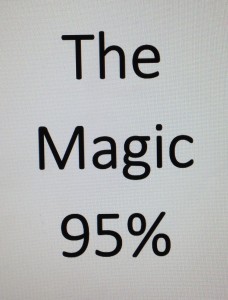 As I mentioned in my last article, most people who claim to have a 95% close rate are either stretching the truth or using some slick sales language. However, your chances of a higher close rate will be greatly increased by implementing a well thought-out, well-executed Referral Partner Cultivation Process (RPCP). Again, finding the right partners is only the beginning; once you’ve found a few star candidates, you are ready for the second phase:
As I mentioned in my last article, most people who claim to have a 95% close rate are either stretching the truth or using some slick sales language. However, your chances of a higher close rate will be greatly increased by implementing a well thought-out, well-executed Referral Partner Cultivation Process (RPCP). Again, finding the right partners is only the beginning; once you’ve found a few star candidates, you are ready for the second phase:
Phase 2: Deepening and defining the relationship!
Laying the ground rules and expectations is paramount for any long-lasting relationship. Not only does it fortify the professional relationship, it sets the stage for mutual credibility and reliability in the eyes of the referred clients. Here are 4 keys to get you started:
1) Become an expert on each other’s business. Spend time deepening your understanding of what your referral partner does, and vice-versa. Discover each other’s nuances, specifically noting what separates your businesses from everyone else’s. Take time to learn about each other’s products and services and basic pricing. Share stories about how you each got into your business, and how you were led to where you are now. Share a few powerful success stories, too; those are critical for bolstering the credibility of your partner. The goal in this phase is to develop a depth of knowledge and build your confidence in each other’s abilities so you’ll be completely at ease when recommending your respective services.
2) Next, explore a variety of ways to best portray and effectively promote each other’s business. For example, does your referral partner want an image of being hip and edgy, or would they prefer conservative and professional? This is critical, particularly for being matched with best fit clients. Also, know what promotional mediums are most likely to reach your target audiences. For instance, one of you might benefit more from social media presence such as a podcast, newsletter or website exposure, while the other might do better being promoted in a print add, as a charity event sponsor, or perhaps via accolades at a networking function. The point is, you need to hash out the opportunities and strategies that will promote each of you in the best light and to the best audience.
3) Spend time getting down to the brass tacks of exactly what you want the referral relationship to look like. Some things to consider: Do you want an exclusive arrangement? What are the specifics regarding quantity and/or quality of referrals? Will there be cross referrals? (Note: In some relationships, there is no reciprocation expected such as when a doctor refers a patient to a physical therapist.) Is your arrangement based on good will, or will referral fees be involved? Are there any other potential (or existing) referral partners you’d like to include in this relationship?
NOTE: It is important to have shared expectations; the more specific and actionable the better. For example, both parties agree to COMMIT to providing two referrals a month to each other. See how this is different than “let’s work together and help each other out.” It requires not only mutual commitment, but also sharing prospect/client lists, strategies discussions and time targets for execution.
4) Execution and evaluation is the final part to making this step in the process a success. Once you’ve clearly set expectations and determined what will be done by when; it’s time to execute. This is really where the rubber meets the road. Help each other identify opportunities, determine the right strategies and get it done. Perhaps you’ve sat down with your referral partner and gone through your respective client lists. Your referral partner has identified a handful of your clients that would make great introductions. You discuss strategies on how to best make the introductions and do some pre-qualifying in the process. Perhaps your strategy is to talk to your client, gauge his interest in meeting your referral partner and arrange a lunch for the three of you to get together. That way, you can really serve as a cheerleader for your referral partner and leverage your relationships with both your referral partner and your client in the process. Afterwards, you have a candid discussion with your referral partner about what went well and how either of you can improve the process.
While there will still be unexpected and unplanned referral opportunities that will present themselves, adding structure and accountability into the referral relationship is a sure-fire way to increase both it’s importance and value to both you and your partner.
Be sure not to rush Phase 2. Hammering out all of the details and laying the groundwork for a professional referral relationship might require a few months of exploring, examining and sorting. Once you’ve both agreed on moving forward, there’s still one more step in the process, and it is by far the most important.
Phase 3 – Minding the relationship
All too often, I’ve seen people work very hard on creating a referral partnership only to watch it wither and die in a short amount of time—and it almost always comes down to a lack of thoroughness with the first two phases. However, the most frustrating reports come from people who were convinced this type of relationship was a waste of time and ended their membership with a referral organization.
In one instance, a client reported that after providing multiple referrals over a period of 6 months to four potential referral partners—none of them gave even one quality referral. He’d even met with each of them, one-on-one, to make sure there was a mutual comprehensive understanding of each other’s business; but still, no referrals were forthcoming.
It seemed like my client was doing everything “right.” He’d taken the time for a series of one-on-one get-togethers to gain a depth of knowledge of the finer points of each other’s business—and to make sure both parties had the best tools for coming up with best-fit client referrals.
So what was missing from this scenario? A personal relationship!
Fact-finding does not build personal relationships. You can gather a plethora of facts about a person or a business, but what will compel you to actively dive into the referral process with focus and intentionality? This process requires energy, and you’ve got to genuinely CARE about someone enough to follow-through on any of this stuff (unless you stand to make a massive amount of money on a single referral, which isn’t usually the case with referral partnerships).
Developing a personal relationship with your referral partner is the key here—and that means building something in multiple layers and facets over time—like any real partnership. Fact-gathering is critical in the beginning phases of a professional relationship, but it will not ultimately get you the desired result, which is: Your partner getting actively involved in the referral process with a genuine desire for YOUR success—and vice versa. That will only come from the relationship you’ve built together. It’s the personal relationship that will compel both of you to make use of the facts gathered in your one-on-one coffee meetings—not the facts themselves. The time you spend together, however long or short, must be personally enriching in some capacity.
It’s important to note here that relationship-building doesn’t require a great deal of effort. Of course, meeting for dinner or going on a fishing trip would be great, but a simple phone call in the middle of the day (just to say hi and shoot the breeze for a few minutes) can go miles in building a relationship. Emailing funny articles, video clips, and stories (of particular interest to your partner) is also a fast and easy way to build a relationship, and requires no rigmarole.
To be clear, I’m not saying you are required to become BFF’s with your referral partner in order for this RPCP arrangement to prove beneficial. I am saying, however, by cultivating an ongoing, personal connection, intentionally doing things with and for your referral partner (outside the realms of making money) you are engaging the key ingredient that activates the entire endeavor and makes all the pieces fall into place. This is what MINDING the relationship all about!
When done with regularity, these simple activities personally deepen and strengthen the bond with your partner, and greatly strengthens the professional relationship. The fact is, any relationship will flourish when you consistently tend and contribute to it over the course of years.
Important question to ask: Is it really worth the time?
Most sales professionals out there don’t have the luxury of time because they have bills to pay and mouths to feed. Aren’t other forms of prospecting less time-consuming?? (e.g. speaking engagements, networking, data mining, and even cold/warm calling referred prospects).
The short answer is yes, those prospecting methods are all faster. AND—it’s still worth your time to cultivate referral partnerships for 3 reasons:
- If you dedicated a small portion of time every week to your RPCP, not only will you generate a great source of referrals, but you will eventually develop personal fans. Referrals that come through this pipeline will be quality and primed to buy from you, and the close rate will likely jump to 95%.
- Referral prospects are effectively pre-sold by your referral partners which gives you a leg up in a sea of ever-increasing competition. Additionally, these prospects have virtually no price sensitivity because they already know how much you charge. Now imagine if all your prospects came to you through a solid RPCP process—that would be a real game changer!
- A true referral partnership doesn’t just enrich your wallet. When approached correctly and sincerely, it also enriches your life with people who become great friends, friends who really know, understand, and look out for each other.
Considering these far-reaching benefits, here’s another important question to ask yourself: How can you afford to NOT make the time?






